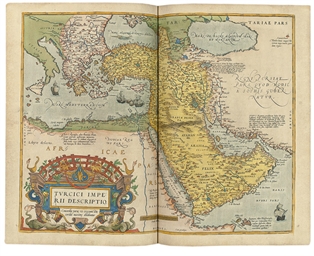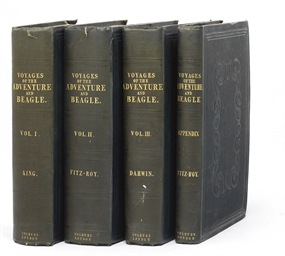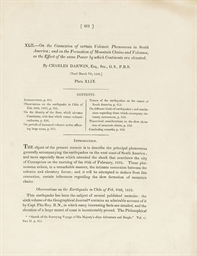BROWN, Peter (fl.1758-1799), Elizabeth MONTAGU, Duchess of Manchester (1741-1832), and [?]other artists. Original drawings of flowering plants from various regions, including the Cape of Good Hope, Carolina and Peru, mounted in three albums, one with manuscript title 'Drawings by Elizabeth, Duchess of Manchester', the drawings dated 1761 to 1782.
BROWN, Peter (fl.1758-1799), Elizabeth MONTAGU, Duchess of Manchester (1741-1832), and [?]other artists. Original drawings of flowering plants from various regions, including the Cape of Good Hope, Carolina and Peru, mounted in three albums, one with manuscript title 'Drawings by Elizabeth, Duchess of Manchester', the drawings dated 1761 to 1782. 3 volumes, large 4°. 133 drawings on vellum pasted on thick paper, on rectos only, in pencil and gouache, some heightened with gum arabic, variably numbered and dated, often with scientific notation. The earliest volume (430 x 355mm), a smaller size than the two others, with 49 original drawings coloured in gouache (typical size 233 x 158mm), mounted within green wash borders. (Some cockling of mounts.) Contemporary red morocco gilt and with onlays, gilt edges. The two later volumes (473 x 400mm) with manuscript title-page and 84 original drawings coloured in gouache (typical size 346 x 245mm), of which 16 are signed 'P. Brown' (typical size 300 x 227mm), again mounted within green wash borders. (Some cockling of mounts, plates 12-14 in the 2nd vol. slightly browned.) Uniform contemporary red morocco gilt and with onlays, gilt edges (all three volumes with minor scuffing and chipping to covers, extremities rubbed, corners slightly bumped). Provenance : Dukes of Manchester at Kimbolton Castle (armorial bookplates and library label); thence by direct descent to the present owner. A MAGNIFICENT SET OF BOTANICAL ALBUMS, including 16 extremely accomplished watercolours signed by Peter Brown (fl. 1758-99). It was during the 18th century that botanical drawing first became a fashionable pastime for aristocratic ladies. Recognised botanical artists toured the countryside, offering their services as a lady's drawing master; the inclusion of Brown's work in these albums strongly suggests that he acted as tutor to Elizabeth Montagu, Duchess of Manchester. She was rightly proud of her work. In a hand-written list of bequests to her friends and family, the Duchess mentions 'three Vol [sic] of paintings Handsomly Bound in Red Moroca I give to My Dear Daughter Lady Emily Montagu As I am sure she will value them -- Being Painted By Me' (Huntingdonshire Archives, M53/3). Elizabeth Montagu (1740/41-1832), eldest daughter of Sir James Dashwood and Elizabeth Spencer, married George Montagu, fourth Duke of Manchester (1737-1788) on 23 October 1762. The earliest drawings therefore slightly pre-date her marriage. She was portrayed with her son George, Viscount Mandeville (1763-1772), by Sir Joshua Reynolds as Diana disarming Cupid in 1766-67. Of Danish descent, Peter Brown was a well-known natural history artist, appointed botanical painter to the Prince of Wales (the future George IV) in 1783. In the mid 1760s, he accepted a commission from Emanuel Medes da Costa (1717-1791), conchologist and palaeontologist, to illustrate his Conchology, or Natural History of Shells (1771). Besides contributing to Pennant's Arctic Zoology (1784-5), he published his own New Illustrations of Zoology in 1776, containing fifty hand-coloured plates. He exhibited at the Free Society of Artists and the Royal Academy between 1766 and 1791. The exaltation of the ideal of a 'return to nature' in the latter part of the 18th century also contributed to the vogue for botanical drawing, which took on a more scientific dimension as the Enlightenment progressed. At the same time, enthusiasm grew for foreign plants. The recurrence of exotic species throughout these albums, chiefly South African but also American, reflects the enquiring spirit of the period. The magnificence and variety of the floral kingdom of the Cape of Good Hope was thought to surpass most other regions of the world. Brown did not travel there, but he is likely to have studied at the Royal Botanic Gardens, Kew, and certainly took part in the dissemination of knowledge about exotic flowers. His granadilla flower, a type of passion flower native to South America, has
BROWN, Peter (fl.1758-1799), Elizabeth MONTAGU, Duchess of Manchester (1741-1832), and [?]other artists. Original drawings of flowering plants from various regions, including the Cape of Good Hope, Carolina and Peru, mounted in three albums, one with manuscript title 'Drawings by Elizabeth, Duchess of Manchester', the drawings dated 1761 to 1782.
BROWN, Peter (fl.1758-1799), Elizabeth MONTAGU, Duchess of Manchester (1741-1832), and [?]other artists. Original drawings of flowering plants from various regions, including the Cape of Good Hope, Carolina and Peru, mounted in three albums, one with manuscript title 'Drawings by Elizabeth, Duchess of Manchester', the drawings dated 1761 to 1782. 3 volumes, large 4°. 133 drawings on vellum pasted on thick paper, on rectos only, in pencil and gouache, some heightened with gum arabic, variably numbered and dated, often with scientific notation. The earliest volume (430 x 355mm), a smaller size than the two others, with 49 original drawings coloured in gouache (typical size 233 x 158mm), mounted within green wash borders. (Some cockling of mounts.) Contemporary red morocco gilt and with onlays, gilt edges. The two later volumes (473 x 400mm) with manuscript title-page and 84 original drawings coloured in gouache (typical size 346 x 245mm), of which 16 are signed 'P. Brown' (typical size 300 x 227mm), again mounted within green wash borders. (Some cockling of mounts, plates 12-14 in the 2nd vol. slightly browned.) Uniform contemporary red morocco gilt and with onlays, gilt edges (all three volumes with minor scuffing and chipping to covers, extremities rubbed, corners slightly bumped). Provenance : Dukes of Manchester at Kimbolton Castle (armorial bookplates and library label); thence by direct descent to the present owner. A MAGNIFICENT SET OF BOTANICAL ALBUMS, including 16 extremely accomplished watercolours signed by Peter Brown (fl. 1758-99). It was during the 18th century that botanical drawing first became a fashionable pastime for aristocratic ladies. Recognised botanical artists toured the countryside, offering their services as a lady's drawing master; the inclusion of Brown's work in these albums strongly suggests that he acted as tutor to Elizabeth Montagu, Duchess of Manchester. She was rightly proud of her work. In a hand-written list of bequests to her friends and family, the Duchess mentions 'three Vol [sic] of paintings Handsomly Bound in Red Moroca I give to My Dear Daughter Lady Emily Montagu As I am sure she will value them -- Being Painted By Me' (Huntingdonshire Archives, M53/3). Elizabeth Montagu (1740/41-1832), eldest daughter of Sir James Dashwood and Elizabeth Spencer, married George Montagu, fourth Duke of Manchester (1737-1788) on 23 October 1762. The earliest drawings therefore slightly pre-date her marriage. She was portrayed with her son George, Viscount Mandeville (1763-1772), by Sir Joshua Reynolds as Diana disarming Cupid in 1766-67. Of Danish descent, Peter Brown was a well-known natural history artist, appointed botanical painter to the Prince of Wales (the future George IV) in 1783. In the mid 1760s, he accepted a commission from Emanuel Medes da Costa (1717-1791), conchologist and palaeontologist, to illustrate his Conchology, or Natural History of Shells (1771). Besides contributing to Pennant's Arctic Zoology (1784-5), he published his own New Illustrations of Zoology in 1776, containing fifty hand-coloured plates. He exhibited at the Free Society of Artists and the Royal Academy between 1766 and 1791. The exaltation of the ideal of a 'return to nature' in the latter part of the 18th century also contributed to the vogue for botanical drawing, which took on a more scientific dimension as the Enlightenment progressed. At the same time, enthusiasm grew for foreign plants. The recurrence of exotic species throughout these albums, chiefly South African but also American, reflects the enquiring spirit of the period. The magnificence and variety of the floral kingdom of the Cape of Good Hope was thought to surpass most other regions of the world. Brown did not travel there, but he is likely to have studied at the Royal Botanic Gardens, Kew, and certainly took part in the dissemination of knowledge about exotic flowers. His granadilla flower, a type of passion flower native to South America, has















Try LotSearch and its premium features for 7 days - without any costs!
Be notified automatically about new items in upcoming auctions.
Create an alert